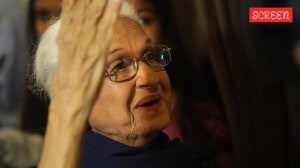Stay updated with the latest - Click here to follow us on Instagram
Can We Have a Word?
Before September 15,when Lehman Brothers still had not declared bankruptcy in New York City,when we still had not looked up subprime crisis in the dictionary...
Exhibitions are no longer enough. Now artists and curators are talking art and luring the arterati like never before
Before September 15,when Lehman Brothers still had not declared bankruptcy in New York City,when we still had not looked up subprime crisis in the dictionary,when art was still blue-chip in India,every other person who thronged Delhis galleries was a connoisseur of colours or at least a pretender with enough cash for a canvas. They were humored with cheap wines and mushroom quiches,while gallerists and curators opted for discreet conversations behind closed doors. Now when the chips are down,when collectors are loath to put their money where a canvas is,gallerists and curators are talking up art like never before. Perhaps the so-called arterati do not know enough,they agonise. When art is not appreciating in the market,perhaps an art-appreciation course will do the trick,they fantasise.
On Monday evening,the photographer Sunil Gupta was sharing details of his camerawork with the UK artist Joy Gregory at the Vadehra Bookstore; last weekend saw 30-odd art enthusiasts trooping to Epicentre,Gurgaon,to attend a two-day art-appreciation course designed by curator Sushma Bahl; and 10 days ago,Neville Tuli addressed a packed audience on The Future Growth of Indias Art & Culture in a chandeliered hall at The Imperial.
Time for Art 101. The idea was to introduce people to the basics, says Bahl. While the opening lecture at the Epicentre was by art historian Parul Pandya Dhar on Introduction to Indian Art: Concepts and Forms,Dr Neeru Mishra acquainted the participants with the painting traditions of India,Serra Pradhan,a New York-based art dealer and adviser,discussed The Western Art Scene: Some Current Practices,and art critic Vinod Bhardwaj talked about the Moderns and Progressives in Indian art. We covered a variety of topics. Investment is still a concern,but the collectors are now showing an urge to learn about art, says Bahl.
Renu Modi,director of Gallery Espace,agrees. Next month,the solo exhibition of Nilima Sheikh at her gallery will be accompanied by a talk by the artist. This will allow a better understanding of her work, says Modi,who also had Kashmiri artist Rajender Tiku explain his artwork to aficionados during an exhibition in December. She had also flown down international art experts to speak to her clients. We have been organising such discussions for many years,but the audience seems to be increasing now. The slowdown might have something to do with it. There is more focus on increasing ones art awareness, she adds. If they are putting their cash on a canvas,they better know if the canvas is a good enough investment.
The coming months will hear more talk. The Devi Art Foundation in Gurgaon has a series of lectures lined up as part of its outreach programme and Parul Vadehra has listed an interactive session with artists and art experts every fortnight at her Bookstore in Defence Colony. These are aimed at art education, says Vadehra,pointing out that the audience for the sessions has been on the rise since the store opened in August 2008. The sessions are open to the public but we send an e-mail to our list of regulars that include artists,students and collectors, says Vadehra. Mukesh Panika,head,Religare arts.i gallery,on the other hand,sends out a team to put up posters,announcing workshops at the gallery,at marketplaces and art colleges. We want to reach out to the masses. Art isnt a prerogative of a handful. For the gallerists,it is helpful if the audience is informed and artists look at workshops as a means to get feedback, says Panika,who is chalking an art-appreciation course that is scheduled to begin at Religare later this year.
Ashok Vajpeyi,chairman of Lalit Kala Akademi,is meanwhile drawing up a list of artists,experts,international art critics and curators,who would be invited by the institute during the next few months to address the audience on relevant issues. These are important to make the study of art more interesting and critical. We will sponsor their trip, says Vajpeyi,who will have Akbar Padamsee speak about his art at the Akademi on March 13.
The sessions aimed at discussing art are easy on the pocket. While it is free at most galleries,the art-appreciation course at Epicentre came for Rs 1,500. Panika is planning to keep the fee to a minimum for the course at Religare. The fee will just cover the basic costs, says Panika. The enthusiasts arent complaining. The knowledge could help take us an informed decision. For someone who is just beginning to collect art,the lectures and workshops do help me develop a base, says homemaker Gurmala Rikhy,who had enrolled for the course at Epicentre. Post the lessons,she hopes to expand her art folio that includes a sizable number of artwork,including a canvas by Sidharth.
hue and cry
* Devi Art Foundation has guided tours of its exhibition Where in the World over the next two months
* Akbar Padamsee will discuss his art at the Lalit Kala Akademi on March 13; more artists and experts will be invited for talks
* A series of interactive sessions is scheduled every fortnight at Vadehra Bookstore
* An art-appreciation course will be introduced at Religare arts.i gallery







